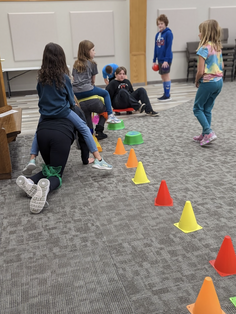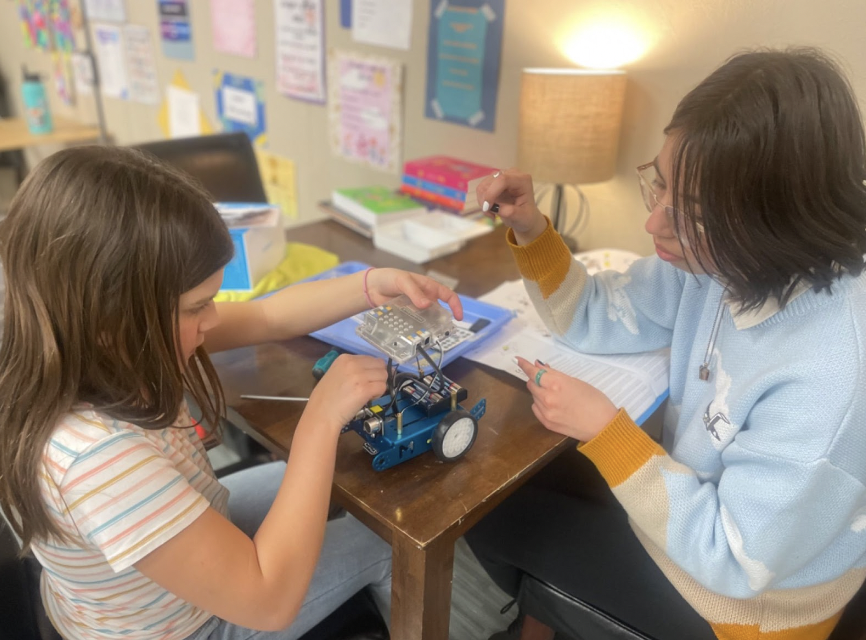|
For the past 3 years, my daughter has attended the Innovation School (TIS). My son just started preschool there this past Fall. During this time, I’ve realized just how valuable mixed age groups are to my children’s development of life skills. Now, as a teacher at TIS, I have gained a new perspective in this wonderfully flexible model of thinking that benefits all ages within our school environment, including teachers. One of the primary benefits of mixed-age learning is that it helps students and teachers recognize that age does not determine a student's ability, experience, or knowledge. In a mixed-age classroom, students have the opportunity to learn from and teach one another, regardless of age. This creates a more inclusive learning environment that values ability at all levels and promotes a growth mindset. Our students are grouped in three bands this school year. Our two TIS Sr. "bands" (groups) have students ranging from 1st-8th grade. This provides many opportunities for interaction, idea-sharing, teaching, and learning from others of many ages. Our students at TIS love time when their peers lead projects, workshops, learning adventures, and day-to-day learning. Many of our projects include collaboration across different ages. Often TIS students will take a survey of their ideas around the school to all the students to gain insight and input. When students lead, teachers facilitate feedback sessions with everyone to gauge how both the leader and learners felt.There is no fear to share an idea or ponder a question because different viewpoints are respected amongst peers with the goal of growth and learning. This mindset of age as a number creates opportunities in reading and math content by having students lead their peers in areas they may have more skill or experience. In this regard, teaching and learning become a shared experience across all members of our school community. From a teacher perspective, the opportunity to teach a child at their skill level rather than solely by age relieves the students and teachers of rushing students through skills and lessons to meet some arbitrary deadline of when they are "supposed to know”. This allows teachers to delve into topics of high interest for students, then interweave content that may be initially less appealing to a student, and incorporate different subjects into a meaningful, relevant learning experience. It allows for mastery of a skill, rather than brief memorization of facts. This approach allows students’ strengths to emerge and be fostered without stressing over where they “should” be academically, simply because of age. It also really allows us, as teachers, to look at the long-term growth of our students as individuals. It affords us the opportunity to meet them where they are within their current capacities and develop them as a whole-person to include their social, emotional, physical, and intellectual development. Another advantage of mixed-age learning is that it can help students maintain their child-like innocence for a longer period of time. Older students can engage within play scenarios that may be considered “childish or naive” in settings of all same-age peers. At TIS, this is the norm and has come to be expected across all ages. Our youngest students are often the leaders of pretend or make-believe play in purest forms and the older students are eager to play along. Our older students regularly teach our younger students games or recreational kinds of play. Play is one of our core values at TIS and our students embody this across the range of ages. This is most often seen during unstructured play of recess and lunch time, but also within our learning adventures, STEM, math, reading, mentor meetings, mindfulness - really it is embedded throughout each school day. Mixed-age learning also provides opportunities for older students to take on leadership roles and mentor younger students. This can help to build confidence and self-esteem, as well as develop valuable skills such as communication, empathy, and collaboration. At the beginning of this year, TIS students who were 10 and older had the opportunity to take on the role of Yellow Band helpers. Yellow band helpers are older students who help our youngest students follow our group agreements and keep them safe within the school environment. If they chose to participate, they submitted an application and met with Ms. Andrea, our Yellow Band teacher, to best understand the expectations of their role. Some of their jobs include helping younger kids get dressed in outdoor gear for recess, walking to and from recess, assisting with lunch items/prep, and providing reminders of appropriate behavior during these times. Each helper is on the rotation for the week. I’ve seen so many of our students rise to this task and develop confidence in this role. And of course, our Yellow Band helper team aren’t the only ones mentoring. All of our TIS Sr. students (grades 1-8) benefit from this responsibility, as it can provide an additional sense of purpose within our school community. We often remind our TIS Sr. students how they have a privilege and a responsibility to lead our school by their example as they are with our youngest students in many day-to-day interactions, including walk, recesses, and lunchtime. At a recent Friday meeting, our students proposed and voted in mentoring our Yellow Band students after gym time on how to organize the gym closet by pairing TIS Sr. students with a Yellow Band student (Pre-K & K). As Yellow Band students learn the process of how to maintain order and cleanliness of our school spaces, they learn to take pride in our school community and environment. Alongside all the benefits of the TIS Sr. students, TIS Jr. also gain skills of trust, confidence, friendship, and citizenship. Through these mentorship opportunities, all of our students learn to trust one another and benefit from being in the community with others. With the size of our school, mixed age learning creates a wonderful family feel. Recently, I observed a great example. Two Yellow Band students collided when passing each other through the doors of the lunch room, resulting in tears and a bloody nose for one. After one of our teachers helped get him cleaned up, he came back to lunch to be greeted by many concerned friends of all ages. Throughout the rest of lunch, he had peers coming to check on him every other minute saying things like "glad you are okay, that looked like it hurt, do you need a hug?". Another example of this I observed was during our end of the day reflection time. At this time, students are given a question to reflect on their day. Examples include questions like: how did you help your physical development today, how did you express your creativity today, or what was a positive interaction you had today. One of our 8th Grade students shared her positive experience playing a fantasy game at recess with the Yellow Band students. The care they have for one another and the "family" love that shines through so often makes for a very warm, loving family feel at TIS. Mixed-age learning at TIS provides a variety of benefits for students. By valuing students’ abilities, maintaining innocence, creating leadership opportunities, and having a family-like feel, TIS creates a more flexible and collaborative learning environment that fosters personal growth and community-building.
0 Comments
Leave a Reply. |
TIS StakeholdersA collection of thoughts, ideas and reflections from our educators, students, and families. Archives
September 2023
Categories |










 RSS Feed
RSS Feed
